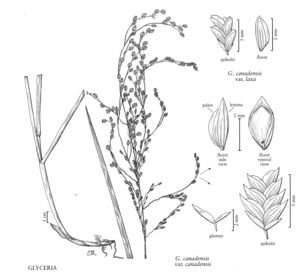familyPoaceae
subfamilyPoaceae subfam. Pooideae
genusGlyceria
sectionGlyceria sect. Striatae
speciesGlyceria canadensis
Difference between revisions of "Glyceria canadensis var. canadensis"
Common names: Canadian glyceria Canadian mannagrass Rattlesnake mannagrass Glycerie du Canada
Endemic
Treatment appears in FNA Volume 24. Treatment on page 79.
FNA>Volume Importer |
imported>Volume Importer |
||
| (4 intermediate revisions by 2 users not shown) | |||
| Line 1: | Line 1: | ||
{{Treatment/ID | {{Treatment/ID | ||
|accepted_name=Glyceria canadensis var. canadensis | |accepted_name=Glyceria canadensis var. canadensis | ||
| − | |accepted_authority= | + | |accepted_authority= |
|publications= | |publications= | ||
|common_names=Canadian glyceria;Canadian mannagrass;Rattlesnake mannagrass;Glycerie du Canada | |common_names=Canadian glyceria;Canadian mannagrass;Rattlesnake mannagrass;Glycerie du Canada | ||
| + | |special_status={{Treatment/ID/Special_status | ||
| + | |code=E | ||
| + | |label=Endemic | ||
| + | }} | ||
|basionyms= | |basionyms= | ||
|synonyms= | |synonyms= | ||
| Line 16: | Line 20: | ||
-->{{Treatment/Body | -->{{Treatment/Body | ||
| − | |discussion=<p>Glyceria canadensis var. canadensis grows through¬out the range of the species. The spikelets bear some resemblance to those of Bromus briziformis, otherwise known as rattlesnake brome, hence the vernacular name "rattlesnake mannagrass".</p> | + | |discussion=<p><i>Glyceria canadensis </i>var.<i> canadensis</i> grows through¬out the range of the species. The spikelets bear some resemblance to those of <i>Bromus briziformis</i>, otherwise known as rattlesnake brome, hence the vernacular name "rattlesnake mannagrass".</p> |
|tables= | |tables= | ||
|references= | |references= | ||
| Line 25: | Line 29: | ||
-->{{#Taxon: | -->{{#Taxon: | ||
name=Glyceria canadensis var. canadensis | name=Glyceria canadensis var. canadensis | ||
| − | + | |authority= | |
| − | |authority= | ||
|rank=variety | |rank=variety | ||
|parent rank=species | |parent rank=species | ||
| Line 33: | Line 36: | ||
|family=Poaceae | |family=Poaceae | ||
|illustrator=Cindy Roché | |illustrator=Cindy Roché | ||
| + | |illustration copyright=Utah State University | ||
|reference=None | |reference=None | ||
|publication title= | |publication title= | ||
|publication year= | |publication year= | ||
| − | |special status= | + | |special status=Endemic |
| − | |source xml=https:// | + | |source xml=https://bitbucket.org/aafc-mbb/fna-data-curation/src/200273ad09963decb8fc72550212de541d86569d/coarse_grained_fna_xml/V24/V24_91.xml |
|subfamily=Poaceae subfam. Pooideae | |subfamily=Poaceae subfam. Pooideae | ||
|tribe=Poaceae tribe Meliceae | |tribe=Poaceae tribe Meliceae | ||
Latest revision as of 17:25, 11 May 2021
Spikelets 5-8 mm, with 4-10 florets. Lower glumes 1.6-2.4 mm; upper glumes 1.8-2.5 mm, acute; lemmas 2.4-4 mm. 2n = 60.
Discussion
Glyceria canadensis var. canadensis grows through¬out the range of the species. The spikelets bear some resemblance to those of Bromus briziformis, otherwise known as rattlesnake brome, hence the vernacular name "rattlesnake mannagrass".
Selected References
None.
Lower Taxa
None.
